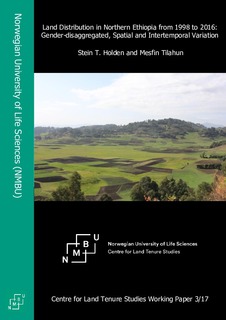| dc.contributor.author | Holden, Stein Terje | |
| dc.contributor.author | Tilahun, Mesfin | |
| dc.coverage.spatial | Ethiopia | nb_NO |
| dc.date.accessioned | 2018-01-31T13:06:01Z | |
| dc.date.available | 2018-01-31T13:06:01Z | |
| dc.date.issued | 2017 | |
| dc.identifier.uri | http://hdl.handle.net/11250/2480997 | |
| dc.description.abstract | This study utilizes land registry data from the First and Second Stage Land Registration Reforms that took place in 1998 and 2016 in sampled districts and communities in Tigray region of Ethiopia. Tigray was the first region to implement low-cost land registration and certification in Ethiopia and providing household level land certificates in the names of household heads. Second Stage Land Registration and Certification (SSLRC) is scaled up since 2015 and provides households with parcel-based certificates with maps. The SSLR&C lists all holders of parcels by name and gender. We utilize the SSLR data for detailed genderdisaggregated analysis after aggregating parcel data by gender to household level and categorizing households in male- and female-headed households. Data from 11 municipalities (tabias) in four districts (woredas) are utilized. This covers 78700 parcels in the SSLR database allocated to 31500 households.
Various statistical measures, including graphical tools, are used to assess the gender-disaggregated,
spatial and intertemporal variation in land distribution. The comparison of First Stage Land Registry
(FSLR) data with SSLR data facilitates critical assessment of the quality of the FSLR data as well as an assessment of changes in farm size distribution over the 18 years period. We find from the total sample of SSLR data, which represents an area of 30000 ha, that the female ownership share for this land is as high as 48.8% and indicates a considerably lower skewness in the distribution between men and women than we had hypothesized. The Gini-coefficient for land distribution among women is lower than that among men (0.45 versus 0.57). The share of male-headed households with no female landowners varied from 25 to 60% across communities. Male-headed households have on average 34% more land than female-headed households but this difference was reduced to less than 10% in terms of land per capita (after correcting for differences in family size between male-headed and female-headed households). There is a clear trend towards smaller farm sizes from the FSLR in 1998 to the SSLR in 2016. The share of farms below one havaries from 0.50 to 0.90 across communities in the SSLR data. | nb_NO |
| dc.language.iso | eng | nb_NO |
| dc.publisher | Norwegian University of Life Sciences, Ås | nb_NO |
| dc.relation.ispartofseries | CLTS Working paper;2017:3 | |
| dc.rights | Attribution-NonCommercial-NoDerivatives 4.0 Internasjonal | * |
| dc.rights.uri | http://creativecommons.org/licenses/by-nc-nd/4.0/deed.no | * |
| dc.subject | Land fragmentation | nb_NO |
| dc.subject | Farm size distribution | nb_NO |
| dc.title | Land distribution in Northern Ethiopia from 1998 to 2016 : gender-disaggregated, spatial and intertemporal variation | nb_NO |
| dc.type | Working paper | nb_NO |
| dc.subject.keyword | Land register | |
| dc.subject.keyword | Farm size | |
| dc.subject.keyword | Gender | |
| dc.subject.keyword | Land ownership | |

